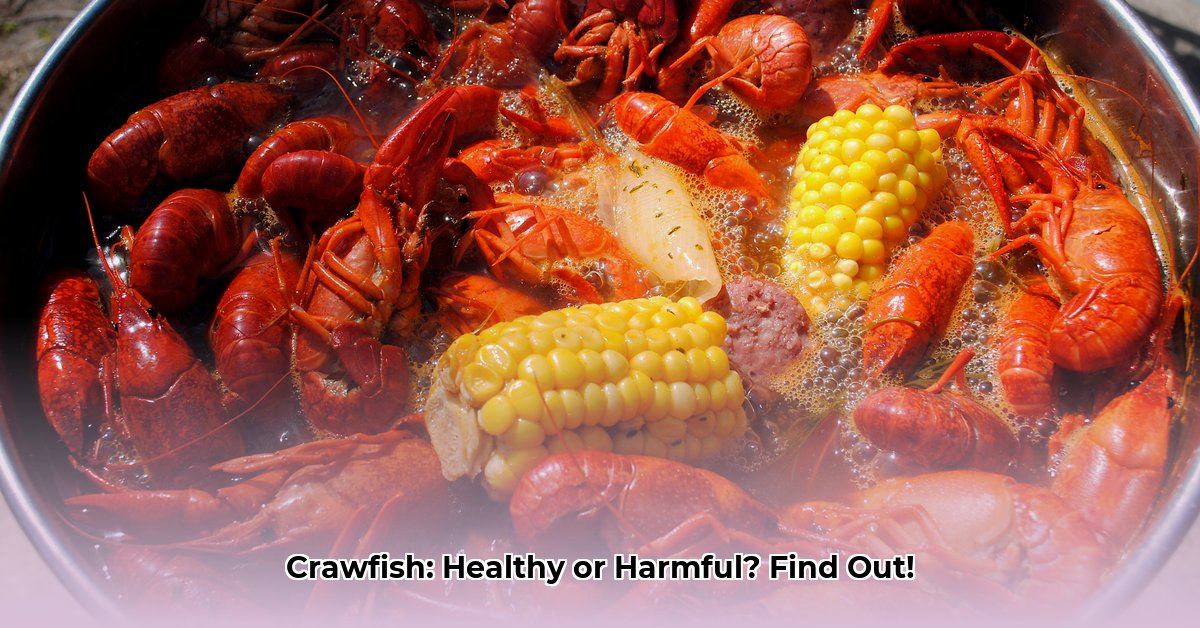Craving crawfish? You’re in good company! These crustaceans are a culinary delight, especially during crawfish season. But are they truly a healthy choice? The answer is nuanced. Crawfish offer impressive nutritional benefits, but it’s essential to be aware of potential health risks and how to mitigate them. This comprehensive guide breaks down everything you need to know, from nutritional facts and potential downsides to safe preparation methods and healthy recipes.
Crawfish: A Nutritional Profile
Crawfish, often compared to miniature lobsters, are a low-calorie, high-protein food source. A 3-ounce serving of peeled crawfish tails contains approximately:
- Calories: 70-85
- Protein: 14-17 grams
- Fat: 1-2 grams (primarily unsaturated)
- Cholesterol: 120-130mg
- Sodium: Varies significantly based on preparation
Beyond these macronutrients, crawfish are rich in several essential micronutrients:
- Selenium: A powerful antioxidant crucial for immune function, thyroid hormone metabolism, and DNA synthesis. A serving of crawfish provides over half the recommended daily value.
- Copper: Essential for energy production, iron metabolism, and nerve function.
- Vitamin B12: Vital for nerve function, red blood cell formation, and DNA synthesis.
The Health Benefits of Crawfish
The nutrients found in crawfish contribute to a variety of health benefits:
- Lean Protein Source: Crawfish are an excellent source of lean protein, essential for building and repairing tissues, supporting muscle growth, and promoting satiety.
- Antioxidant Protection: Selenium’s antioxidant properties help protect cells from damage caused by free radicals, potentially reducing the risk of chronic diseases.
- Supports Energy Production: Copper plays a vital role in energy production, helping your body convert food into usable energy.
- Boosts Immune Function: Selenium and other nutrients in crawfish contribute to a healthy immune system, helping your body fight off infections.
Potential Downsides and Health Risks
While crawfish offer numerous benefits, it’s important to be aware of the potential risks:
- Cholesterol Content: Crawfish contain a significant amount of cholesterol. While dietary cholesterol’s impact on blood cholesterol is less significant than saturated and trans fats for most people, those with high cholesterol or heart disease should consume crawfish in moderation.
- High Sodium Content: Traditional crawfish boils are notorious for their high sodium content. Excessive sodium intake can lead to high blood pressure, water retention, and other health problems.
- Paragonimiasis Risk: Eating undercooked or raw crawfish can lead to Paragonimiasis, a parasitic infection affecting the lungs. This risk can be avoided with proper cooking.
- Shellfish Allergies: Shellfish allergies are common, and crawfish are a common allergen. Allergic reactions can range from mild skin irritation to severe, life-threatening anaphylaxis.
Smart Cooking Methods for Healthier Crawfish
The way you prepare crawfish significantly impacts its nutritional profile and potential health risks:
- Prioritize Steaming or Grilling: Steaming or grilling crawfish are healthier alternatives to boiling, as they minimize the addition of excess salt and fat.
- Control the Sodium: If boiling, use low-sodium seasoning blends and avoid adding excessive amounts of salt. Consider making your own seasoning blend to control the ingredients.
- Add Healthy Vegetables: Incorporate a variety of non-starchy vegetables into your crawfish boils, such as broccoli, cauliflower, green beans, and mushrooms, to increase the nutritional value and reduce the proportion of high-sodium ingredients.
- Avoid Frying: Frying crawfish adds significant amounts of unhealthy fats and calories, negating many of its health benefits.
Crawfish Preparation: A Step-by-Step Guide
Follow these steps for safe and delicious crawfish preparation:
- Purging (Optional): Some people prefer to purge crawfish before cooking to remove any impurities. Place the crawfish in a large container with salted water for about 30 minutes.
- Washing: Rinse the crawfish thoroughly under cold running water several times to remove any dirt or debris.
- Cooking: Cook crawfish until they turn bright red and their tails curl tightly. Ensure the internal temperature reaches 145°F (63°C) to kill any potential parasites or bacteria.
- Serving: Serve immediately and enjoy!
Healthy and Delicious Crawfish Recipes
Here are a few ideas for enjoying crawfish in a healthy way:
- Steamed Crawfish with Lemon and Herbs: Steam crawfish with fresh lemon slices, garlic, and your favorite herbs for a simple and flavorful dish.
- Crawfish Salad with Avocado: Combine cooked crawfish with avocado, mixed greens, and a light vinaigrette for a healthy and satisfying salad.
- Crawfish Etouffee with Brown Rice: Make a lighter version of this classic Cajun dish using low-sodium broth, whole-wheat flour, and brown rice.
- Crawfish Tacos: Fill whole-wheat tortillas with cooked crawfish, salsa, avocado, and a squeeze of lime for a delicious and healthy meal.
Responsible Consumption: Enjoying Crawfish Safely and in Moderation
Crawfish can be a part of a healthy diet when consumed responsibly. Here are a few tips:
- Practice Moderation: Enjoy crawfish as an occasional treat rather than a dietary staple.
- Be Mindful of Portion Sizes: Stick to a reasonable serving size (around 3-5 ounces of peeled crawfish tails) to control cholesterol and sodium intake.
- Hydrate: Drink plenty of water to help flush out excess sodium.
- Choose Reputable Sources: Purchase crawfish from reputable vendors to ensure freshness and quality.
The Verdict: Are Crawfish Healthy?
Crawfish offer several nutritional benefits, including being a lean protein source rich in selenium, copper, and vitamin B12. However, their high cholesterol and potential for high sodium content in traditional preparations are important considerations. By choosing healthy cooking methods, practicing portion control, and sourcing crawfish responsibly, you can enjoy this culinary delicacy as part of a balanced and nutritious diet.
- Mini Bento Boxes For Packing Kids Snacks And Small Meals - December 27, 2025
- Small Bento Box Makes Packing Lunch Easy and Fun Again - December 26, 2025
- Adult Bento Box Lunch Ideas For Quick Healthy Portable Options - December 25, 2025










